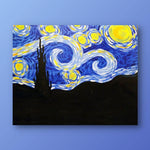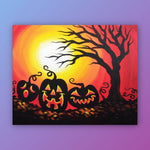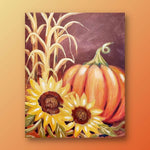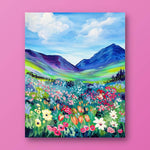How To Get Started With Acrylic Painting - Painting for Beginners
Do you want to learn how to paint using acrylic paints - but don't know where to start?! If you've never painted before - painting can seem intimidating.
- Where do I find the right acrylic painting materials?
- Where do I find beginner painting instruction?
- What's an easy painting for beginners to paint?
All these are common questions and leave many too afraid to pick up a brush. But painting is easier than you think and once you start - you'll realize how much fun it is and let your inner artist shine.
We'll cover these questions and more in our step-by-step guide below.
Acrylic Paint
Acrylic paint has a distinct set of properties that make it different from oils and watercolors – and perfect for beginners.
- Dries very quickly and is easy to work with
- Sharp lines and brushstrokes
- Standout colors that pop and can be used on a variety of different mediums such as wood and canvases.
- Can look completely different based on the techniques you use

What Should I Paint
The options are endless on what you can potentially paint. Here's a list off paintings ideas to get you started.
- Classic Paintings like The Starry Night (see our free video tutorial below)
- Your favorite skyline
- Your favorite animal or a pet
- Fish
- Stars
- The Sky
- Waves
- Childhood memories (Catching fireflies)
- A lit up street
- Your favorite sports teams logo
- Your favorite tree
- A street lit park bench
What Brushes Do I Need?

Each paintbrush has a number after the name of the brush - the larger the number, the wider the brush.
You don’t need all these brushes. We recommend that you buy the following synthetic brushes to get started - Round 1, Round 6, Filbert 8 and Flat 12. This 5-brush set is commonly used in many painting classes and is also included in our Studio Kit and Essentials Kit.
To learn more about brushes and how to take care of them - check out our post on brush care.
What Paints Do I Need?
As we mentioned earlier, acrylic painting is very easy to work with - which makes it great for beginners. For colors, start with basic tubes of red, blue, yellow, black and white. Keep in mind you can mix colors together to create any additional hues/colors you need.
There are two different thicknesses or “body” for acrylic paints: heavy body (thicker) and soft body (thinner). Heavy body is more popular because it allows you to paint with more textures.
Don't buy too much a large quantity at the outset, acrylic paints last a while and you’ll also be mixing the paints with water. An 8 oz tube will last a while. Don't forget your palette to mix the paints - we recommend a 8" x 10" heavy paper board.
What Techniques Do I Need to Learn?
Now that we've talked through the items you need for acrylic painting, let's talk about the mediums you can potentially paint on: canvas, wood or fabrics. For beginners, the easiest medium is canvas - buy a 16"x20" canvas that that doesn't require pre-treatment. If you choose to go with a canvas, grab an easel so you can paint comfortably while you sit.
Color Mixing
We’ll provide you with some quick color mixing tips, but a lot of it has to do with experimentation.
1) Don't use black to make colors dark - adding black paint typically leads to colors being more cloudy and muddied.
2) A touch of white or a lighter version of the color you are using will add a differentiated hue to the color. Adding the color white to any color will help with hue and opacity as well.
3) Make your blues deeper in color by adding – red to it. Who knew?!
Now we’ll go over some painting techniques.
Dabbing
Dabbing is similar to taking a web sponge and putting it onto a canvas. It is a commonly used technique that creates a unique texture. We used the splatter technique to create the backdrop for our Lovebirds At Dusk painting

Drybrush
When you take a completely dry brush, put some paint on it and then apply it to a canvas you will create a strong color on the canvas. The lines will be rigid and uneven because there is no water to smooth it out. The dry-brush technique leads to a unique look with jagged edges.

Washing
The perfect technique when you want to see texture - dilute the paint with water and it’ll set with the texture applied.

Stippling
This technique allows you to create smaller dots. Dip your paintbrush into the color, hold it perpendicular to the surface, and then touch the tip of the paintbrush to the surface several times. Keep repeating as long as needed.
No Matter What Keep Having Fun
It's fine if the painting isn't perfect - it's yours! Have fun, relax and create something.
For a live demo, check out the video tutorial above - it has some of the techniques we covered and shows you how to use all the materials.
General FAQ
- ◄What do I need to start painting?
- The following items are needed to get started with acrylic painting: acrylic paints, paintbrushes, canvas, thick paper palette, cup of water, easel or table to set canvas on.
- ◄What type of paint is best for beginners?
-
Acrylic paints are the best to start since they dry easily, easy to mix, and easy to clean up. Oils take a longer amount of time to dry and are not as easy to apply.
- ◄What colors do I need to get started with acrylic painting?
- We recommended starting out with small amounts of basic colors which include the following: White, Black, Red, Yellow and Blue. These basic colors can be mixed to create varying hues and additional colors.
- ◄What types of paintbrushes do I need for acrylic painting?
- We recommend that you buy the following synthetic brushes to get started Round 1, Round 6, Filbert 8 and Flat 12. These brushes can be used to carry out most acrylic painting techniques.


















